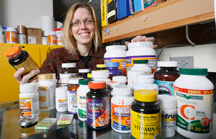Vitamins stored in bathrooms, kitchens may become less effective

Lisa Mauer, a Purdue associate professor of food science, has shown that subjecting certain products, such as vitamin C, to humidity can chemically change their compositions, eliminating the health benefits associated with those products. (Purdue Agricultural Communication photo/Tom Campbell)
WEST LAFAYETTE, Ind. - High humidity present in bathrooms and kitchens could be degrading the vitamins and health supplements stored in those rooms, even if the lids are on tight, a Purdue University study shows.
Lisa Mauer, an associate professor of food science, said that crystalline substances - including vitamin C, some vitamin B forms and other dietary supplements - are prone to a process called deliquescence, in which humidity causes a water-soluble solid to dissolve. Keeping those supplements away from warm, humid environments can help ensure their effectiveness.
"You might see salt or sugar start to cake in the summer, start to form clumps, and that's a sign of deliquescence," said Mauer, whose findings were published in the early online version of the Journal of Agricultural and Food Chemistry. "You can also get chemical instabilities, which are a little more problematic if you're consuming a dietary supplement with vitamin C for that vitamin C content."
Kitchen salt, sugar and powdered drink mixes commonly cake, Mauer said, making their measurement more difficult but not rendering them useless. Chemical changes become more than a nuisance in vitamins and dietary supplements, however.
"If you get some moisture present or ingredients dissolve, they'll decrease the quality and shelf life of the product and decrease the nutrient delivery," Mauer said. "You can get complete loss of the ingredients. It depends on the conditions. It depends on the formulations. Within a very short time - in a week - you can get complete loss of vitamin C in some products that have deliquesced."
Bathrooms and kitchens can increase the detrimental effects because of spikes in humidity in those rooms. And Mauer said storing vitamins or supplements in containers with lids doesn't always help.
"Opening and closing a package will change the atmosphere in it. If you open and close a package in a bathroom, you add a little bit of humidity and moisture each time," Mauer said. "The humidity in your kitchen or bathroom can cycle up quite high, depending on how long of a shower you take, for example, and can get higher than 98 percent."
Mauer used a gravimetric moisture sorption balance to determine the humidities at which substances would deliquesce. The samples spiked in weight at the deliquescence point because moisture was being adsorbed, meaning humidity was condensing on the solid and then the solid dissolved.
Different crystalline substances deliquesce at different humidities, Mauer said. For example, at room temperature, sodium ascorbate would deliquesce at 86 percent humidity, ascorbic acid at 98 percent humidity and fructose at 62 percent. Some ingredient blends deliquesce in as low as 30 percent humidity. Different forms of ingredients, such as the two forms of vitamin C studied (ascorbic acid and sodium ascorbate), have different deliquescence points, different sensitivity to moisture and different degradation rates. At high enough humidities, samples dissolved completely.
Once humidity or temperature is brought back down, the product will solidify, Mauer said, but the damage has been done.
"Any chemical changes or degradation that have occurred before resolidification don't reverse. You don't regain a vitamin C content after the product resolidifies or is moved to a lower humidity," she said. "The chemical changes we've observed are not reversible."
This information could be important to anyone using vitamin-containing products, ranging from the consumer to the food and dietary supplement industry and ingredient suppliers. Storing products in dry conditions, below their deliquescence relative humidities, can avoid unwanted ingredient loss.
Consumers could notice liquid in vitamin containers, but Mauer said another sign of nutrient degradation is brown spots, especially on children's vitamins. Mauer suggested discarding any dietary supplement that is showing signs of moisture uptake or browning.
"They're not necessarily unsafe, but why give a vitamin to a kid if it doesn't have the vitamin content you're hoping to give them?" Mauer said. "You're just giving them candy at that point with a high sugar content."
The U.S. Department of Agriculture and the Lilly Endowment Inc. funded the research.
Writer: Brian Wallheimer, 765-496-2050, bwallhei@purdue.edu
Source: Lisa Mauer, 765-494-9111, mauer@purdue.edu
Steve Leer, sleer@purdue.edu
Agriculture News Page
Note to Journalists: A video in which Lisa Mauer describes deliquescence and its effects can be viewed at https://www.youtube.com/user/Purdueagriculture. The video, b-roll and interview footage can be downloaded for use on the Web or on air at ftp://news69.uns.purdue.edu/Public/Mauer%20Deliquescence
ABSTRACT
Influence of Simultaneous Variations in Temperature and Relative Humidity on Chemical Degradation of Two Vitamin C Forms and Implications
for Shelf-Life Models
Ashley N. Hiatt, Lynne S. Taylor, Lisa J. Mauer
Vitamin C powder ingredients are popular food fortificants and one of the most commonly added nutrients. While information on degradation kinetics and shelf-life of vitamin C exists, current models are limited in their applicability to systems where RH and temperature are varied simultaneously, and where phase transformations occur. This study monitored degradation of two forms of vitamin C (sodium ascorbate and ascorbic acid) under various RH and temperature conditions. Vitamin C was measured colorimetrically, and stability data were used to improve understanding of vitamin C shelf-life when deliquescence occurs during storage. RH and temperature both significantly impacted vitamin stability, though RH had a larger effect. Vitamin dissolution preceded extensive degradation and was found to be a good predictor of vitamin C loss. This research highlights the importance of considering phase transformations when constructing shelf-life models and maintaining vitamin C in the solid state for enhanced stability.
